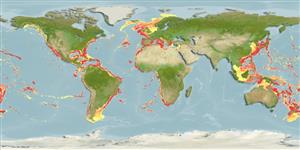Common names from other countries
Classification / Names / Names
Populärnamn | synonymer | Catalog of Fishes (gen., sp.) | ITIS | CoL | WoRMS
Environment: milieu / climate zone / depth range / distribution range
Ekologi
Pelagiska; djupintervall 0 - 1600 m (Ref. 116114). Tropical
Indo-Pacific, Atlantic Ocean, and the Mediterranean.
Length at first maturity / Size / Vikt / Age
Maturity: Lm ? range ? - ? cm Max length : 9.0 cm WD hane/ej könsbestämd; (Ref. 2376)
Up to 6.5 cm wide; nematocyst warts on exumbrella very variable in size and number. Color very variable.
Neritic, estuarine, potentially pathogenic (Ref. 116114). A holoplanktonic, oceanic and semi-cosmopolitan species (Ref. 19) inhabiting offshore warm waters (Ref. 813); non symbiotic but often appears in high numbers (Ref. 7694). Feeds on salps, doliolids, larvaceans, hydromedusae, ctenophores, chaetognaths, planktonic crustaceans and fish eggs (Ref. 2376).
Life cycle and mating behavior
Könsmognad | Reproduktion | Lek | Ägg | Fecundity | Larver
Members of the class Scyphozoa are gonochoric. Life cycle: Egg is laid by the adult medusa which later develops into a free-living planula, then to a scyphistoma to a strobila, and lastly to a free-living young medusa.
Migotto, A.E., A.C. Marques, A.C. Morandini and F.L. da Silveira. 2002. (Ref. 813)
IUCN Red List Status (Ref. 130435)
CITES status (Ref. 108899)
Not Evaluated
Not Evaluated
Human uses
| FishSource |
Verktyg
Internet-källor
Estimates based on models
Preferred temperature
(Ref.
115969): 3.1 - 12.5, mean 7.1 (based on 1107 cells).
Vulnerability
Low vulnerability (10 of 100).
Price category
Unknown.
